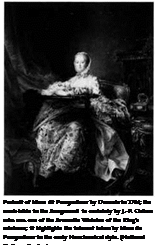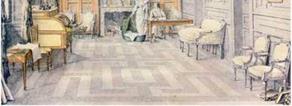|
T |
he factors that made Paris the capital of commerce for luxury goods in the eighteenth century are well known. France was then the richest country in Europe, with the highest population, and its capital was a great city with a love of ostentation and novelty. The numerous contemporary descriptions of Paris bear witness to the sumptuousness of Parisian houses and the admiration which they evoked in foreign capitals. Shameless luxury was the order of the day Voltaire’s L’Apologie du Luxe (which was also entitled La Defense du Mondain). written in 1720. expressed a common sentiment rather than a new idea. The taste for luxury was a driving force in the economy, of which the authorities were well aware and which they sought to encourage. Thus in 1730 Louis XV gave an order for several large lengths of embroidered silk, even though he had no precise use for them, with the sole aim of encouraging the industry in Lyon. Not until 1783. with the advent of the ‘moralists’ and the obsession with the national debt, did luxury veil itself behind a feigned austerity and a ruinous simplicity. Later. Napoleon I. continuing the Bourbon tradition, made efforts to revive the furniture industry by giving orders to numerous Parisian £b£nistes.
Royal orders play an essential role in the history of furnituremaking during the period of our study Whether for reasons of political expediency or personal taste, the royal family surrounded itself with sumptuous furnishings which were frequently replaced. Ebe – nistes in royal service were usually highly innovative; Pierre Verlet. in his four volumes on French royal furniture, has highlighted the originality of many of their creations. However, there were long breaks between royal orders, corresponding to the wars at the end of the reign of Louis XIV. which dried up Treasury funds from 1690. and the minority of Louis XV until 1735. For almost a half a century. Paris took over the lead from Versailles. The two great ebe – nistes of the period. Boulle and Cressent. completed few commissions for the Crown; they worked rather for Parisian financiers and noblemen. The royal family at Versailles by no means had a monopoly on ostentation; in Paris the princes of the blood, the ministers and financiers sought the same sumptuous furniture as did the king. Louvois ordered cabinets of pietra-dura [9j from Oppenordt comparable to those which Cucci was making at the same time for Louis XIV. while the Due de Bourbon ordered furniture of a similar luxury from Boulle. In the same room in the Wal
lace collection there are two commodes by Gaudreaus [117. 123). incontestably the finest examples of the Regence style; one belonged to Louis XV and the other to a financier, M. de Selle, who also owned sumptuous furniture by Cressent [88. 92j.
The most interesting document on the clientele and taste of the middle of the eighteenth century remains the Lime Journal of Lazare Duvaux, whose author supplied furniture to the King and the royal family, the Dauphin and especially the Dauphine. His principal client was Mine de Pompadour whose name occurs no less than 499 times in the ten years covered by the day-book. Ministers and members of the Parlcment were also clients of Duvaux. He furnished the Chateau d’Asnieres for the Marquis d’Argcnson, the Hotel de Roquelaure and the Chateau de Champlatreux for President Mole. Amongst the ministers in the circle of Mme de Pompadour. the names of Choiseul and Bemis are mentioned. Some figures from the Court are among the important clients (the Comte du Luc, the Comtesse d’Egmont. the Duchesse de Lauraguais. the Marquis de Gontaut. the Due de Bouillon, the Duchesse de Brancas and the Marquis de Brancas, the Due d’Aumont and the Due de la Vallifcre). Finally, the most numerous clients are certainly the financiers (M. de la Reyntere. Paris de Montmartel. Blondel d’Azincourt, Blondel de Gagny, MM. de Boulogne father and son. de Caze. Dang£. Fonspertuis, Fabus Roussel. Bouret de Villaumont and de Verdun). A well-known engraved portrait of Paris de Montmartel before 1766 [270] helps to explain how the taste of the Fermicrs G£n£- raux could rival that of the royal family. The vanity of the Fermiers Generaux in this domain was unbridled: for example, the young Gri – mod d’Orsay had Riesener make a copy of the famous ‘bureau du roi’ even before Riesener had finished the piece for Louis XV.
 At the end of the eighteenth century the houses of the financiers were amongst the finest in Paris and were described in accounts by foreign visitors. The Baronne d’Oberkirch who accompanied the Comtesse du Nord to Paris in 1782. returning in 1784, glowingly described the house of Grimod de la Reyntere. and particularly that of Beaujon. (The house is furnished magnificently, mostly old furniture and wonderful vernis Martin. They showed us a mahogany staircase and a dining-table in the same wood for thirty places. I will say nothing of the statues, the pictures, and amazing objects to be found at every step; one could do with a catalogue [. . .)’). At the end of the eighteenth century, besides the financiers and the noblemen, the eb£niste’s clients included courtesans; they were noted at the time for the sumptuous decor of their surroundings, settling together in the new houses of the Chauss£e d’Antin and the Faubourg du Roule and collecting the most precious furniture of Japanese lacquer and pietra-dura. with a predilection, it seems, for furniture with porcelain plaques. This taste was illustrated by the sale in 1782 of the furniture of Mile Laguerre in which various pieces by Carlin were included, such as the small lacquer secretaire [416] or the commode in pietra-dura now in the Brit-
At the end of the eighteenth century the houses of the financiers were amongst the finest in Paris and were described in accounts by foreign visitors. The Baronne d’Oberkirch who accompanied the Comtesse du Nord to Paris in 1782. returning in 1784, glowingly described the house of Grimod de la Reyntere. and particularly that of Beaujon. (The house is furnished magnificently, mostly old furniture and wonderful vernis Martin. They showed us a mahogany staircase and a dining-table in the same wood for thirty places. I will say nothing of the statues, the pictures, and amazing objects to be found at every step; one could do with a catalogue [. . .)’). At the end of the eighteenth century, besides the financiers and the noblemen, the eb£niste’s clients included courtesans; they were noted at the time for the sumptuous decor of their surroundings, settling together in the new houses of the Chauss£e d’Antin and the Faubourg du Roule and collecting the most precious furniture of Japanese lacquer and pietra-dura. with a predilection, it seems, for furniture with porcelain plaques. This taste was illustrated by the sale in 1782 of the furniture of Mile Laguerre in which various pieces by Carlin were included, such as the small lacquer secretaire [416] or the commode in pietra-dura now in the Brit-


ish Royal Collection (415]. The Baronne d’Oberkirch once again recorded her impressions after a visit to another courtesan. Mile Dervieux. ‘On leaving the Palais-Royal, we went to see the little house and garden of Mile Dervieux. the famous courtesan. It was a delicious confection! The furnishings are worth a king’s ransom. The Court and the town have paid her tribute.’ On the subject of Mile Guimard she adds.
this famous lady, in spite of the enormous sums of money that she has cost so many people of the Court and the town, finds herself in financial embarrassment (…] and wants to offer her house in a lottery. It is valued at 5<X).(XX)L and it’s really quite another matter from Mile Dcrvicux’s house. They talked of a Chinese cabinet which was worth crazy amounts (…) it was. people said, unique in Europe, even in Holland there isn’t another one like it; we gazed at it as something out of this world.
However, fine furniture was not reserved for the dlite. If the ambience of the Court and high finance set the tone, they were closely followed by the provincial and Parisian bourgeoisie. The middle classes were also benefiting from the prosperity currently enjoyed by the country and were developing a taste for luxury, described by Roubo and denounced by moralists such as Louis-Sebastien Mer – cier: ‘When the house is built you haven’t even started! That’s only a quarter of the expense. Along comes the menuisier. the decorator.

the eb^niste. etc., and the interior takes three times longer than the construction of the building |…| the emphasis on magnificent furnishings is out of all proportion.’ It is difficult to form an idea of an eighteenth-century middle-class interior; the only known pictorial representations show sumptuous interiors. In paintings by Chardin and Greuze old-fashioned furniture in natural wood may be seen; it is dear that the middle classes could not renew their furniture with the same frequency as the elite.
Л study by Annik Pardailhc-Galabrun. La Naissance de iintime, based on probate inventories of 3.000 Parisian households during the seventeenth and eighteenth centuries, gives an accurate picture of bourgeois interiors of the period. Whereas in modest households the furniture mainly comprised beds, cane chairs and strictly utilitarian furniture, in the more affluent households there were pieces of furniture that were as much decorative as functional, and this survey indicates the large amount of storage furniture such as armoircs and commodes that was to be found in all bourgeois houses. The taste for comfort and intimacy that had developed in well-to-do society during the eighteenth century was reflected in the furnishing of interiors by a progressive specialization in the use of space – the appearance of dining-rooms, drawing-rooms, bed-rooms, boudoirs etc. instead of the chambers or halls which made up seventeenth-
century houses. Parallel with this was a large increase in furniture made for a specific function: tables for writing or for dinner, dressing-tables. work-tables, tea-tables, gamcs-tables. night-tables, etc The quest for comfort by the middle classes was as much responsible for the development of Parisian ebenisterie of the period as the aristocratic taste for ostentation.



